Preliminary Analysis of the Impact of Finishing Layers on the Hygroscopic Performance of Vernacular Earthen Plasters from Santiago, Chile
Abstract
:1. Introduction
2. Materials and Methods
2.1. Sampled Coatings from Vernacular Buildings in Santiago
2.2. Material Testing of Finishing Layers
2.2.1. Optical Microscopy and Microchemical Study
2.2.2. SEM and FTIR-ATR Analysis
2.3. Sorption/Desorption Tests
3. Results and Discussion
3.1. Material Characterization of Finishing Layers
3.1.1. Optical Microscopy and Microchemical Results
3.1.2. SEM Analysis
3.1.3. FTIR-ATR Results
3.2. Sorption/Desorption Results
4. Conclusions
Author Contributions
Funding
Data Availability Statement
Acknowledgments
Conflicts of Interest
Appendix A
| Samples | ES (mm) | EF (mm) | Substrate | Coating local |
|---|---|---|---|---|
| MN_C10_1 | 40.0 | 10.0 | Adobe | Interior |
| SC_C10_02 | 12.5 | 12.5 | Adobe | Exterior |
| SC_C10_03 | 17.5 | 10.0 | Adobe | Interior |
| MS_TOC_01 | 20.0 | 6.0 | Fired brick | Interior |
| MS_TOC_02 | 25.0 | 20.0 | Adobe-filled timber frame—adobe en pandereta | Interior |
| MS_TOC_03 | 30.0 | 20.0 | Fired brick | Interior |
| BY_CHA_01 | 20.0 | 10.0 | Embedded adobe-filled timber frame—adobillo | Interior |
| BY_JJVV_01 | 45.0 | 10.0 | Adobe | Interior |
| BY_MAK_01 | 22.5 | 5.0 | Earth- and fiber-filled timber frame—quincha | Interior |
| BY_MAK_02 | 17.5 | 10.0 | Adobe | Exterior |
| MS_JJVV_01 | 20.0 | 10.0 | Adobe-filled timber frame —adobe en pandereta | Exterior |
| Thickness Average | 24.5 | 11.2 |
References
- Jorquera, S.N.; Soto, R.C. The Basement of the San Francisco Church: An Earthquake-Resistant Foundation on a Prehispanic Layer? ARQ Santiago 2016, 93, 106–117. [Google Scholar] [CrossRef]
- Benavides Rodríguez, A.; Benavides Courtois, J. La Arquitectura en el Virreinato del Perú y en la Capitanía General de Chile; Editorial Andrés Bello: Santiago, Chile, 1988. [Google Scholar]
- Jorquera, N. Patrimonio Chileno Construido en Tierra; ARQ Ediciones: Santiago, Chile, 2022. [Google Scholar]
- Rivera Vidal, A.; Gómez Maestro, C. Heritage and Community Centre in Matta Sur, Chile. In Proceedings of the HERITAGE2022 International Conference on Vernacular Heritage: Culture, People and Sustainability, Valencia, Spain, 15–17 September 2022; UPV: Valencia, Spain, 2022; pp. 1063–1069. [Google Scholar] [CrossRef]
- Bass, A.; Porter, D.; Spilde, M.; Guebard, M.; Shaum, K.; Ferriola, N. Characterization and Comparative Analysis of Ancient Earthen Plasters from the American Southwest. MRS Adv. 2017, 2, 2145–2178. [Google Scholar] [CrossRef]
- Veiga, M.R.; Santos Silva, A.; Tavares, M.; Santos, A.R.; Lampreia, N. Characterization of Renders and Plasters from a 16th Century Portuguese Military Structure: Chronology and Durability. Restor. Build. Monum. 2013, 19, 223–238. [Google Scholar] [CrossRef]
- Salavessa, E.; Jalali, S.; Sousa, L.M.O.; Fernandes, L.; Duarte, A.M. Historical Plasterwork Techniques Inspire New Formulations. Constr. Build. Mater. 2013, 48, 858–867. [Google Scholar] [CrossRef]
- Beas, M.I.G. Traditional Architectural Renders on Earthen Surfaces. Master’s Thesis, University of Pennsylvania, Philadelphia, PA, USA, 1991. Available online: https://repository.upenn.edu/hp_theses/395 (accessed on 24 May 2025).
- Marchante, P.; Silva, P. Los revestimientos en la conservación del patrimonio construido con tierra en Santiago de Chile. Mem. Semin. Iberoam. Arquit. Constr. Con Tierra-SIACOT 2017, 17, 400–406. [Google Scholar]
- Marchante, P.; Vidal, A.R. Characterization of Traditional Coatings in Earthen Vernacular Architecture in the Limarí Valley: Their Role in the Conservation of Built Heritage in Chile. J. Tradit. Build. Archit. Urban. 2022, 3, 384–395. [Google Scholar] [CrossRef]
- Marchante, P.; Rivera Vidal, A.C. Revestimientos Tradicionales de Santiago, 1st ed.; MINCAP: Santiago, Chile, 2023. [Google Scholar]
- Ranesi, A.; Faria, P.; Veiga, M.R. Traditional and Modern Plasters for Built Heritage: Suitability and Contribution for Passive Relative Humidity Regulation. Heritage 2021, 4, 2337–2355. [Google Scholar] [CrossRef]
- Jorquera-Silva, N.; Lobos-Martínez, M.L. Technique and Material Configuration of Santiago de Chile’s Old Town at the Beginning of the 20th Century. An Interpretation Based on Municipal Cadasters from 1910 to 1939. AUS 2017, 22, 46–52. [Google Scholar] [CrossRef]
- Rivera Vidal, A.; Gómez Maestro, C.; Marchante, P. Matta Sur, ejemplo de patrimonio urbano de tierra en Santiago, Chile. Mem. Semin. Iberoam. Arquit. Constr. Con Tierra-SIACOT 2023, 21, 532–540. [Google Scholar]
- Candeias, A.E.; Nogueira, P.; Mirão, J.; Santos Silva, A.; Veiga, R.; Gil Casal, M.; Ribeiro, I.; Seruya, A.I. Characterization of Ancient Mortars: Present Methodology and Future Perspectives. In Ext. Abst. of CERC3 Workshop on Chemistry in the Conservation of Cultural Heritage, EU-ARTECHP; John Wiley and Sons: Hoboken, NJ, USA, 2006; pp. 4–7. [Google Scholar]
- Volhard, F. Light Earth Building: A Handbook for Building with Wood and Earth; Birkhäuser: Basel, Switzerland, 2016. [Google Scholar]
- Feigl, F. Spot Tests in Organic Analysis; Elsevier Science B. V.: Amsterdam, The Netherlands, 1966. [Google Scholar] [CrossRef]
- Feigl, F.; Angern, V. Spot Tests in Inorganic Analysis; Elsevier Science B. V.: Amsterdam, The Netherlands, 1972. [Google Scholar]
- Kulkarni, V.S.; Shaw, C. Use of Polymers and Thickeners in Semisolid and Liquid Formulations, In Essential Chemistry for Formulators of Semisolid and Liquid Dosages; Academic Press: Cambridge, MA, USA, 2016; pp. 43–69. [Google Scholar] [CrossRef]
- DIN 18947; Earth Plasters—Requirements, Test and Labelling. Deutsches Institut fur Normung: Berlin, Germany, 2024.
- Lima, J.; Faria, P.; Santos Silva, A. Earth plasters: The influence of clay mineralogy in the plasters’ properties. Int. J. Archit. Herit. 2020, 14, 948–963. [Google Scholar] [CrossRef]
- Odegaard, N. Microchemical Tests in Conservation. In The Encyclopedia of Archaeological Sciences; López Varela, S.L., Ed.; John Wiley & Sons: Hoboken, NJ, USA, 2018. [Google Scholar] [CrossRef]
- Doménech-Carbó, M.T.; Doménech-Carbó, A. Spot tests: Past and present. ChemTexts 2022, 8, 4. [Google Scholar] [CrossRef] [PubMed]
- Pasta muro Interior. Available online: https://www.sipa.cl/productos/pasta-muro-y-selladores/pasta-muro-interior (accessed on 21 March 2025).
- Siedel, H.; Siegesmund, S.; Sterflinger, K. Characterisation of Stone Deterioration on Buildings. In Stone in Architecture; Springer: Berlin/Heidelberg, Germany, 2011; pp. 347–410. [Google Scholar] [CrossRef]
- Braun, J.H.; Baidins, A.; Marganski, R.E. TiO2 Pigment Technology: A Review. Prog. Org. Coat. 1992, 20, 105–138. [Google Scholar] [CrossRef]
- Lima, J.; Faria, P. Eco-efficient earthen plasters: The influence of the addition of natural fibers. In Natural Fibres: Advances in Science and Technology Towards Industrial Applications. From Science to Markets; Fangueiro, R., Rana, S., Eds.; RILEM Bookseries; Springer: Dordrecht, The Netherlands, 2016; Volume 12, pp. 315–327. [Google Scholar] [CrossRef]
- Santos, T.; Gomes, M.I.; Silva, A.S.; Ferraz, E.; Faria, P. Comparison of Mineralogical, Mechanical and Hygroscopic Characteristic of Earthen, Gypsum and Cement-Based Plasters. Constr. Build. Mater. 2020, 254, 119222. [Google Scholar] [CrossRef]
- McGregor, F.; Heath, A.; Maskell, D.; Fabbri, A.; Morel, J.-C. A Review on the Buffering Capacity of Earth Building Materials. Proc. Inst. Civ. Eng.-Constr. Mater. 2016, 169, 241–251. [Google Scholar] [CrossRef]
- Santos, T.; Faria, P.; Sotomayor, J.; Silvestre, J.D.; Santos Silva, A. Effect of Different Surface Treatments on the Performance of Earth Plasters. Coatings 2024, 14, 1537. [Google Scholar] [CrossRef]



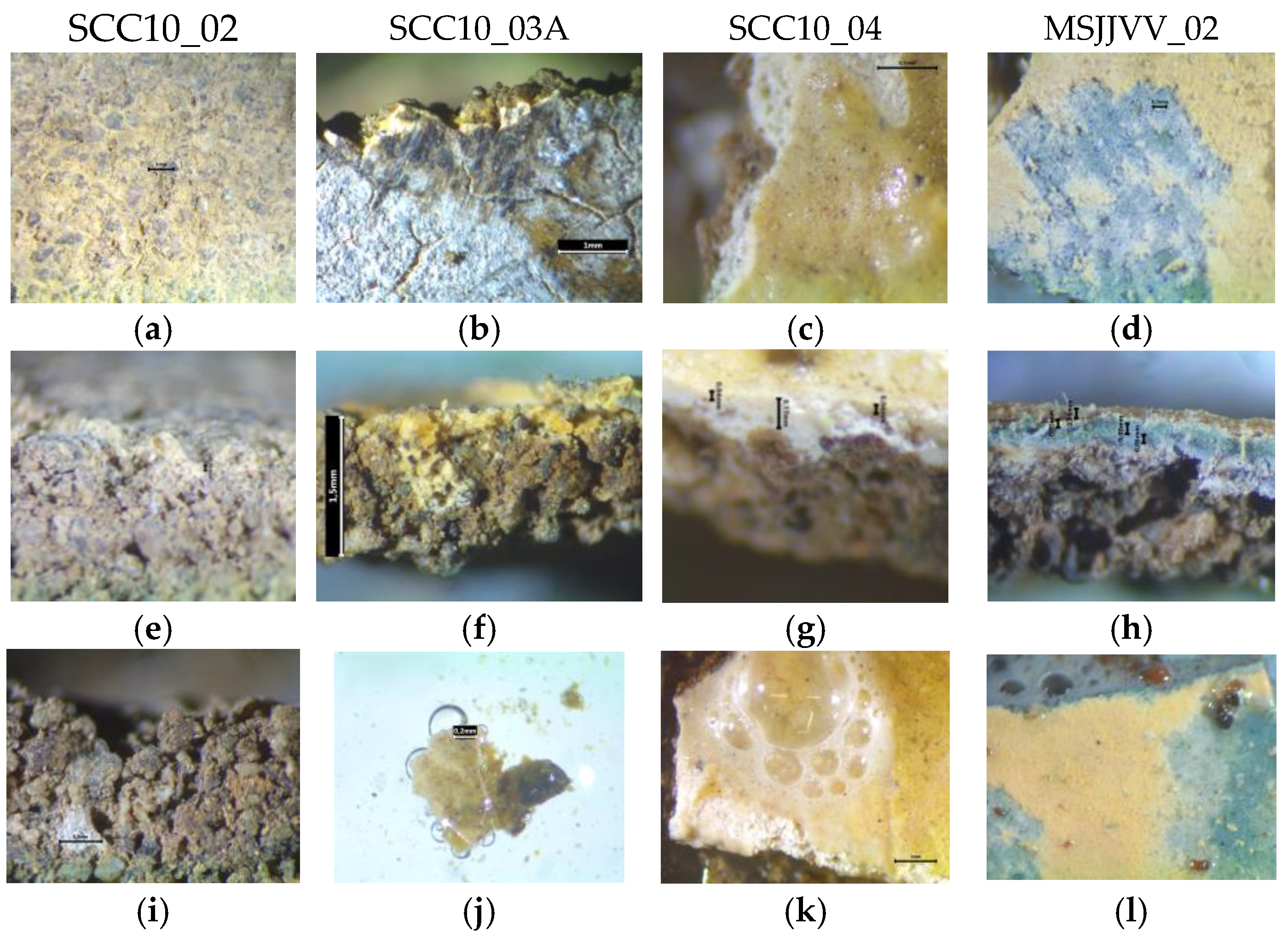
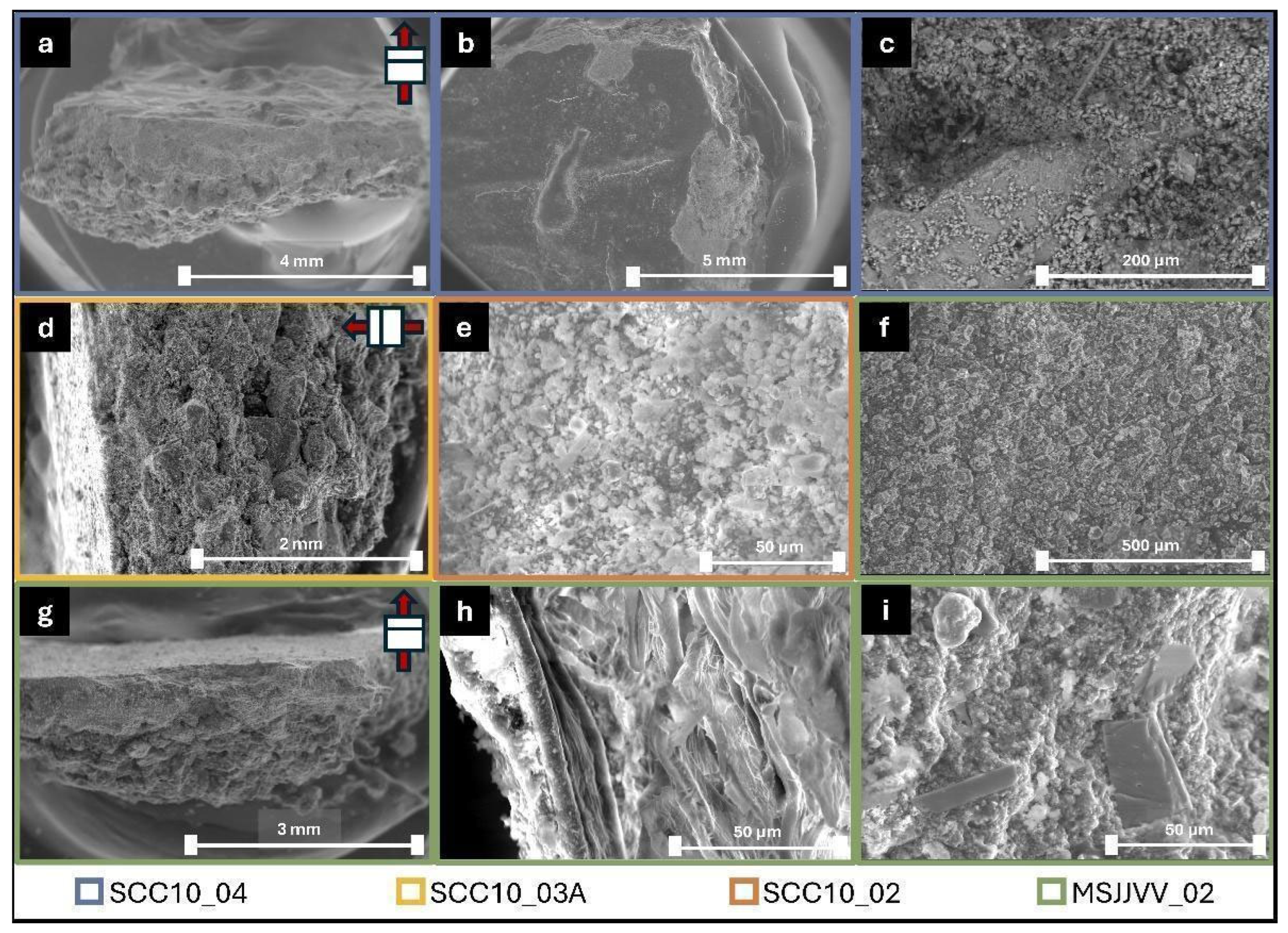

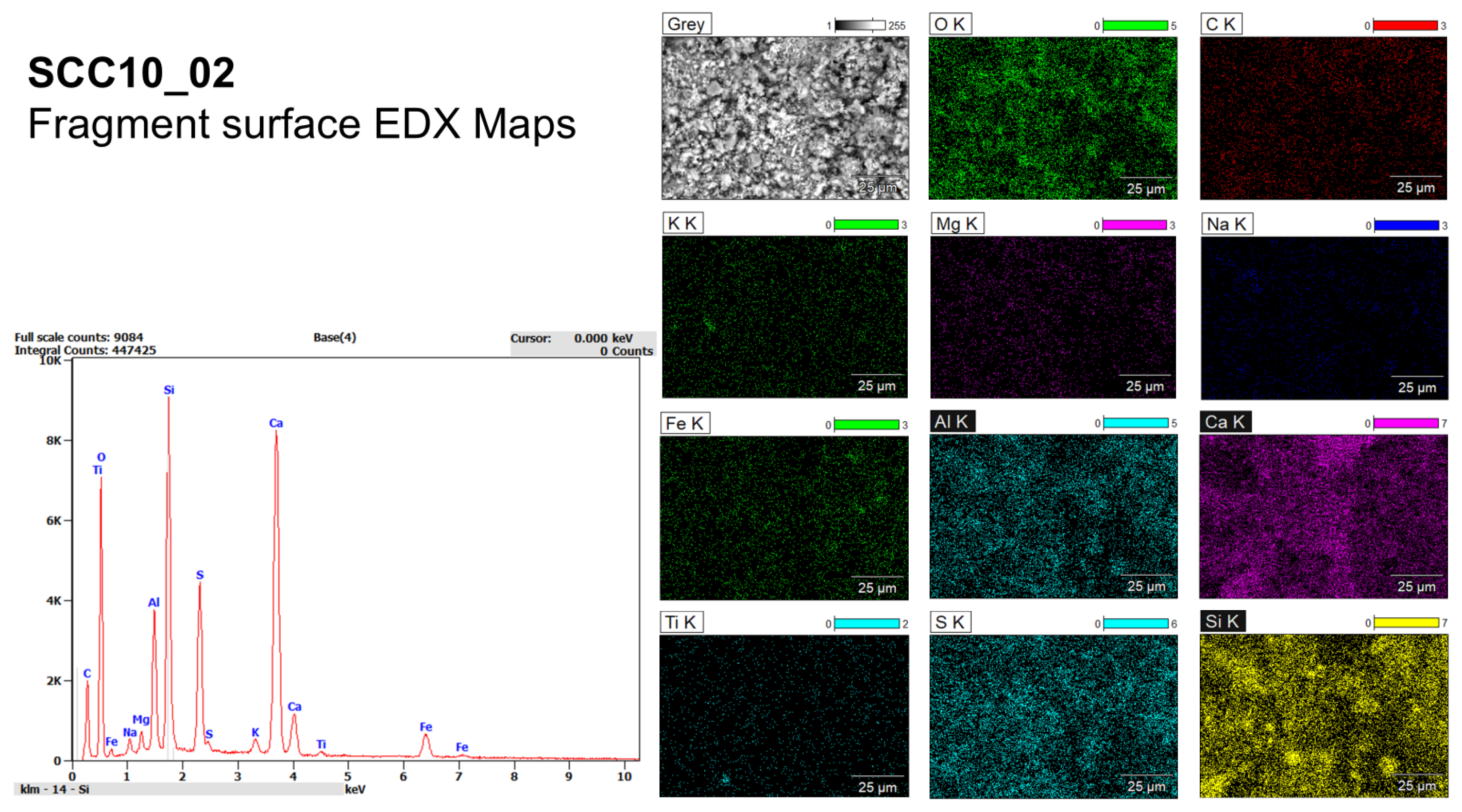

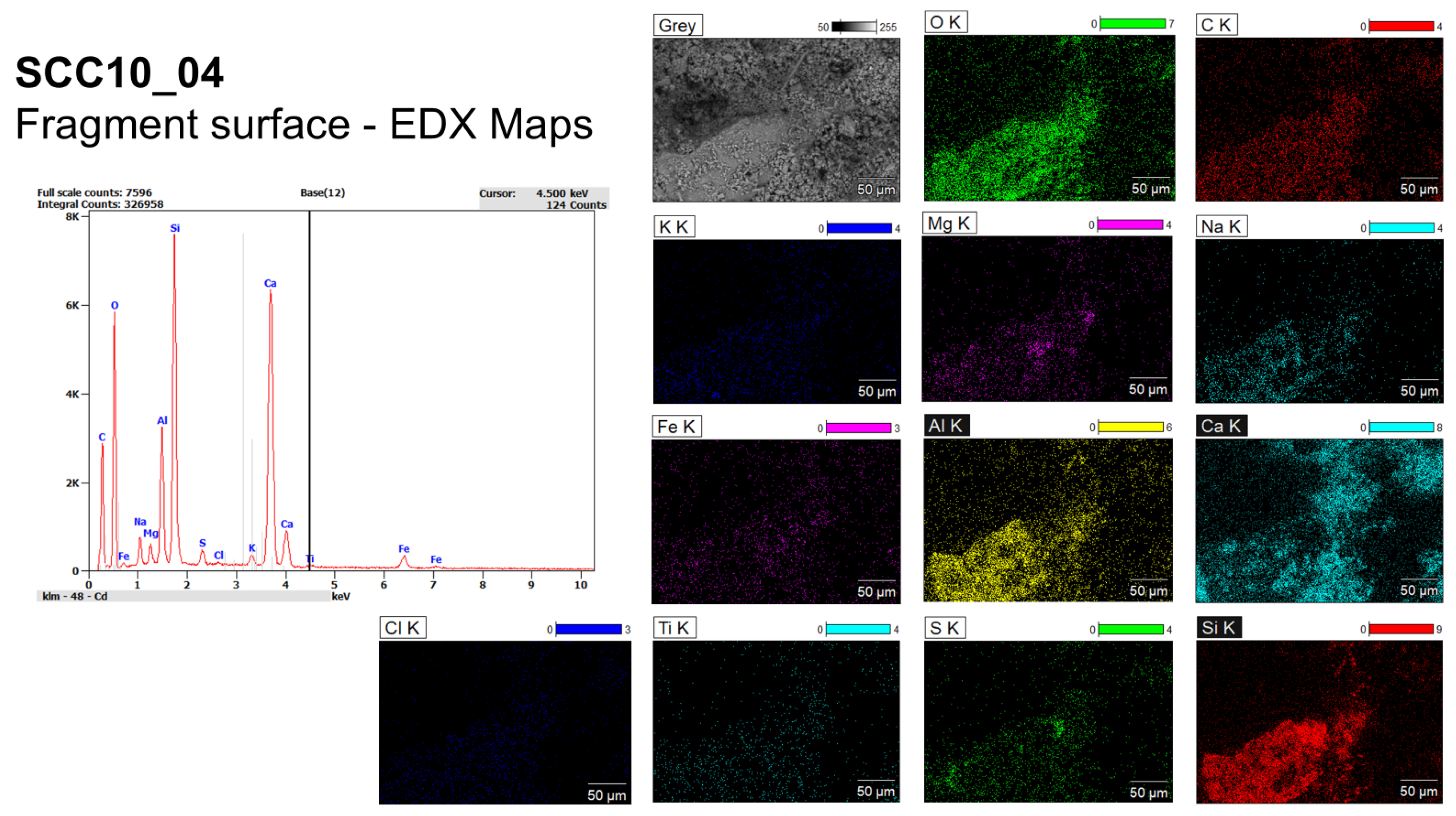
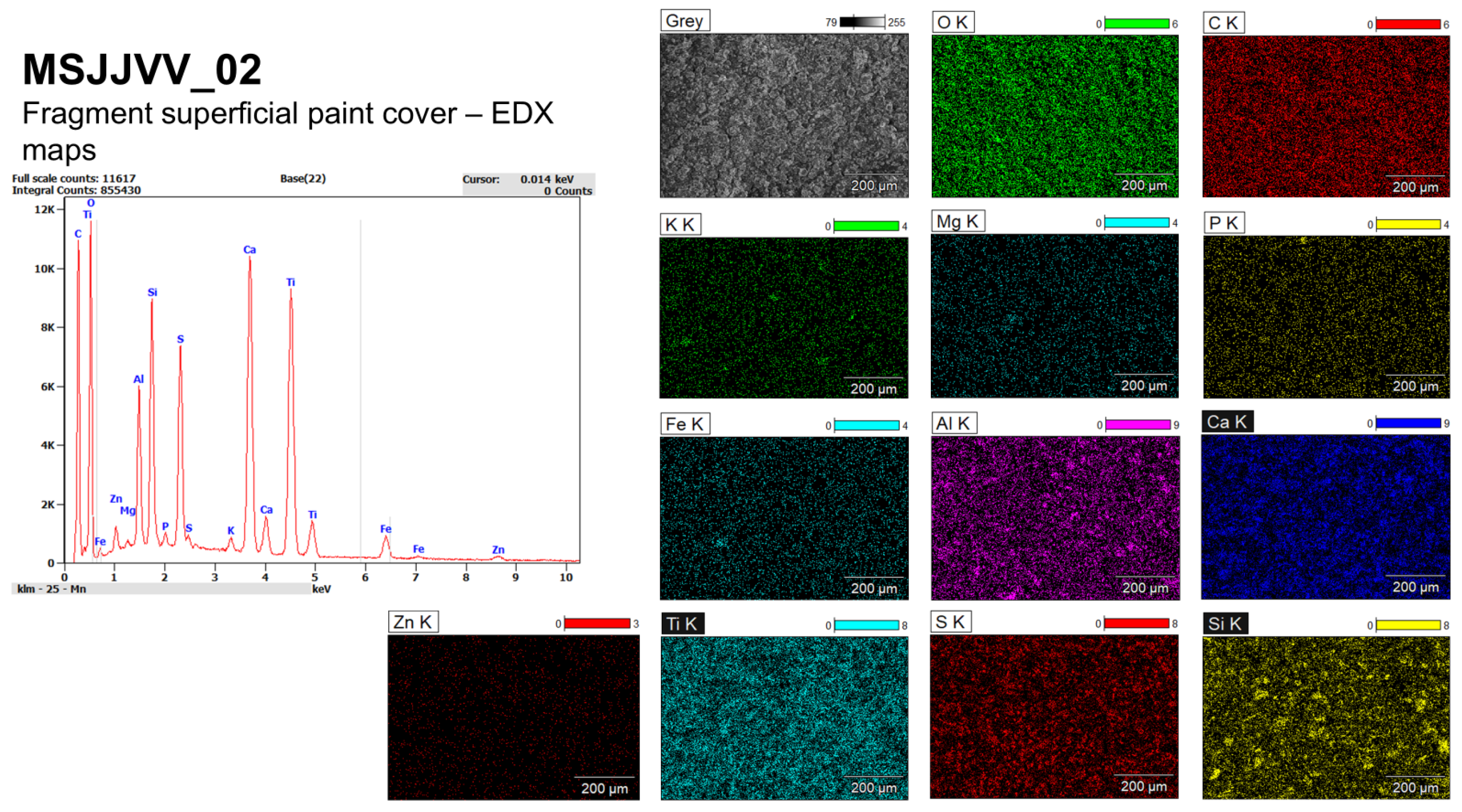

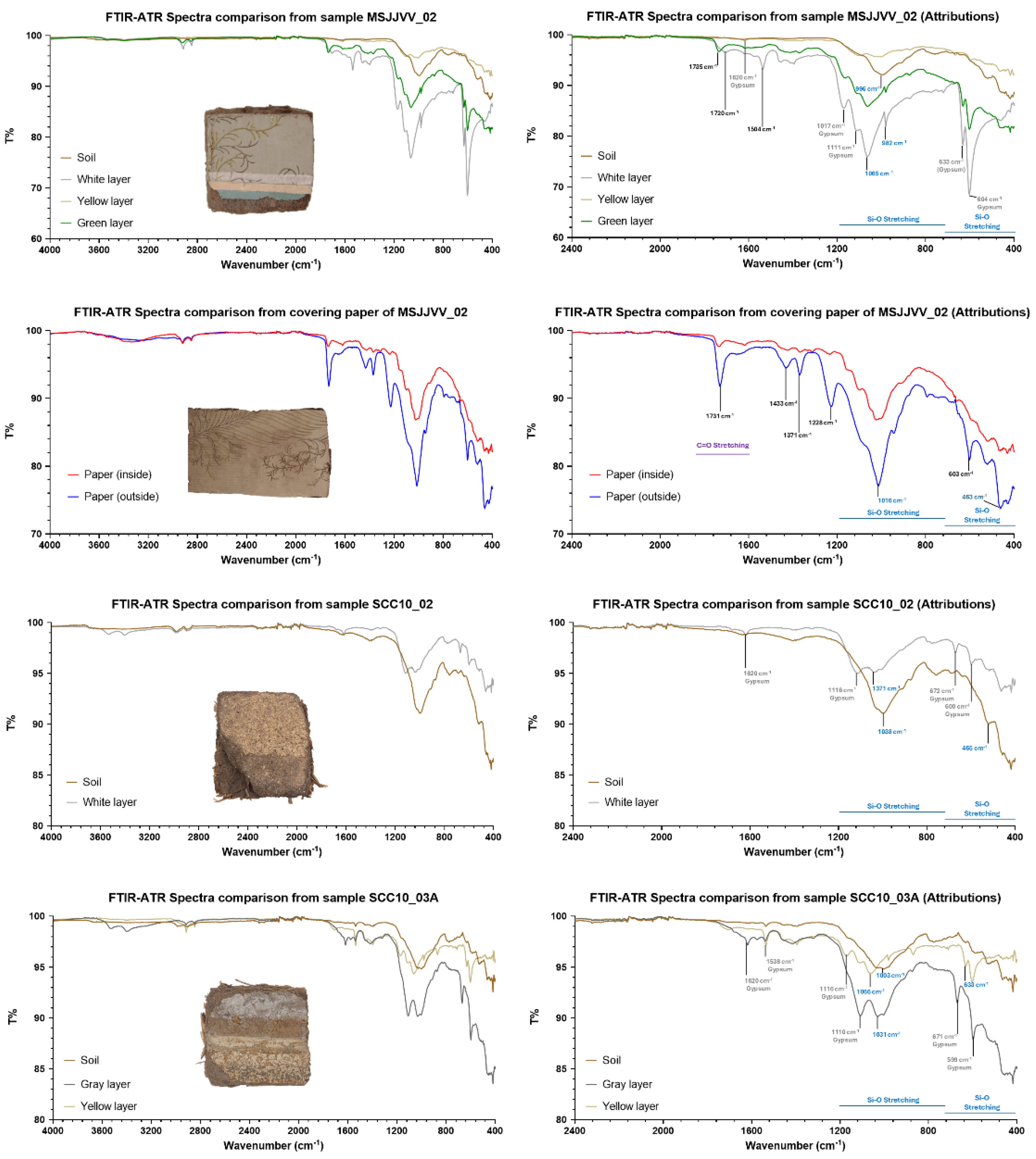

| Sample | ES (mm) | EF (mm) | Substrate | Local | ||||
|---|---|---|---|---|---|---|---|---|
| Average | MinT | MaxT | Average | MinT | MaxT | |||
| SCC10_02 | 11.3 | 7.0 | 16.0 | 18.5 | 11.6 | 23.0 | Adobe | Exterior |
| SCC10_03A | 10.0 | 9.0 | 11.0 | 20.6 | 17.0 | 26.0 | Adobe | Interior |
| SCC10_04 | 11.4 | 9.0 | 15.0 | 21.9 | 16.0 | 30.0 | Adobe | Interior |
| MSJJVV_02 | 10.8 | 9.0 | 15.0 | 14.7 | 4.0 * | 30.0 | Adobe-filled timber frame—adobe en pandereta | Interior |
| CASE STUDIES | MS JJVV_02 | SCC10_02 | SCC10_03A | SCC10_04 |
|---|---|---|---|---|
| With Finishing | ||||
| MC 24 h (sorption) [g/m2]—A | 31.857 | 152.000 | 83.978 | 69.980 |
| Remaining MC 48 h (desorption) [g/m2]—B | 14.795 | 46.930 | 39.009 | 29.191 |
| Percentage of released MC (A − B)/A [%] | 54 | 69 | 54 | 58 |
| Without finishing | ||||
| MC 24 h (sorption) [g/m2]—A | 103.883 | 161.832 | 129.560 | 106.631 |
| Remaining MC 48 h (desorption) [g/m2]—B | 23.312 | 50.508 | 37.834 | 26.453 |
| Percentage of released MC (A − B)/A [%] | 78 | 69 | 71 | 75 |
| Δ 24 h sorption without/with finishing | 3.26 | 1.06 | 1.54 | 1.52 |
Disclaimer/Publisher’s Note: The statements, opinions and data contained in all publications are solely those of the individual author(s) and contributor(s) and not of MDPI and/or the editor(s). MDPI and/or the editor(s) disclaim responsibility for any injury to people or property resulting from any ideas, methods, instructions or products referred to in the content. |
© 2025 by the authors. Licensee MDPI, Basel, Switzerland. This article is an open access article distributed under the terms and conditions of the Creative Commons Attribution (CC BY) license (https://creativecommons.org/licenses/by/4.0/).
Share and Cite
Marchante, P.; Rivera Vidal, A.; Murgia, S.; Navarro Ezquerra, A.; Achenza, M.; Faria, P. Preliminary Analysis of the Impact of Finishing Layers on the Hygroscopic Performance of Vernacular Earthen Plasters from Santiago, Chile. Buildings 2025, 15, 1930. https://doi.org/10.3390/buildings15111930
Marchante P, Rivera Vidal A, Murgia S, Navarro Ezquerra A, Achenza M, Faria P. Preliminary Analysis of the Impact of Finishing Layers on the Hygroscopic Performance of Vernacular Earthen Plasters from Santiago, Chile. Buildings. 2025; 15(11):1930. https://doi.org/10.3390/buildings15111930
Chicago/Turabian StyleMarchante, Patrícia, Amanda Rivera Vidal, Simone Murgia, Antonia Navarro Ezquerra, Maddalena Achenza, and Paulina Faria. 2025. "Preliminary Analysis of the Impact of Finishing Layers on the Hygroscopic Performance of Vernacular Earthen Plasters from Santiago, Chile" Buildings 15, no. 11: 1930. https://doi.org/10.3390/buildings15111930
APA StyleMarchante, P., Rivera Vidal, A., Murgia, S., Navarro Ezquerra, A., Achenza, M., & Faria, P. (2025). Preliminary Analysis of the Impact of Finishing Layers on the Hygroscopic Performance of Vernacular Earthen Plasters from Santiago, Chile. Buildings, 15(11), 1930. https://doi.org/10.3390/buildings15111930










